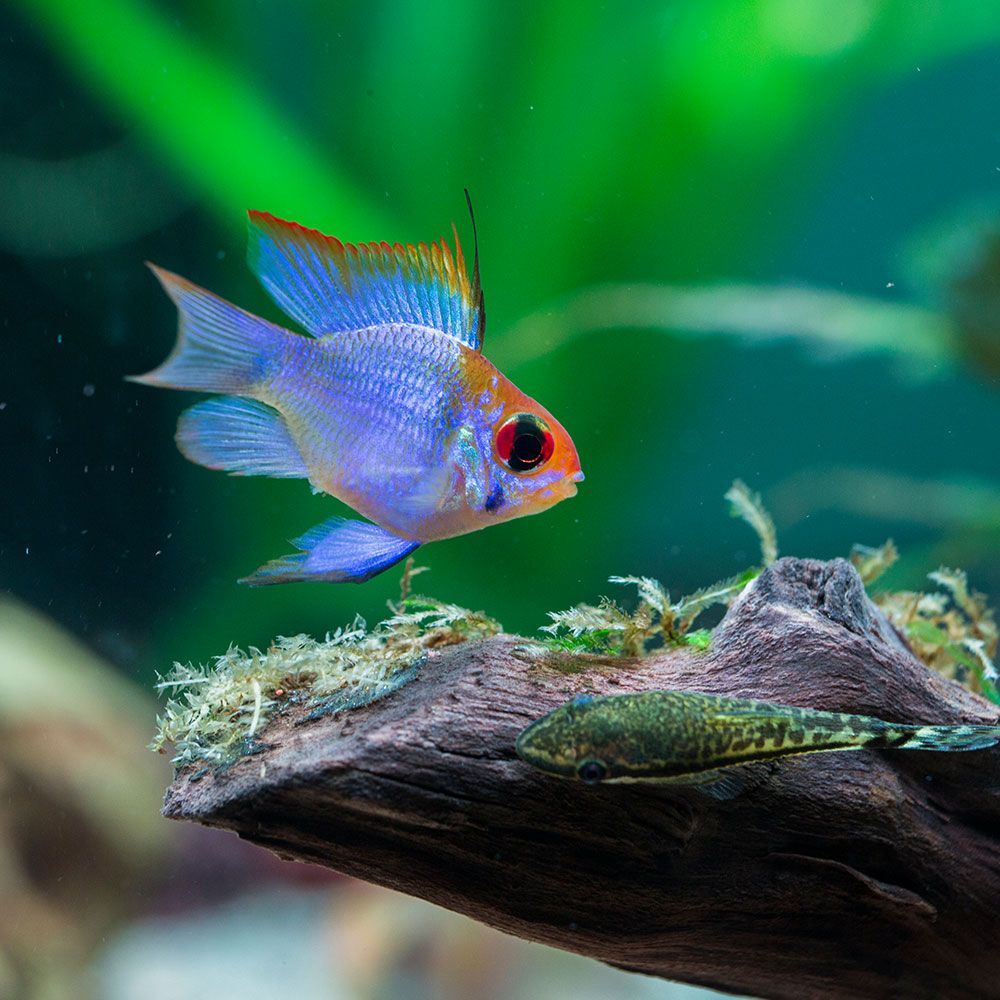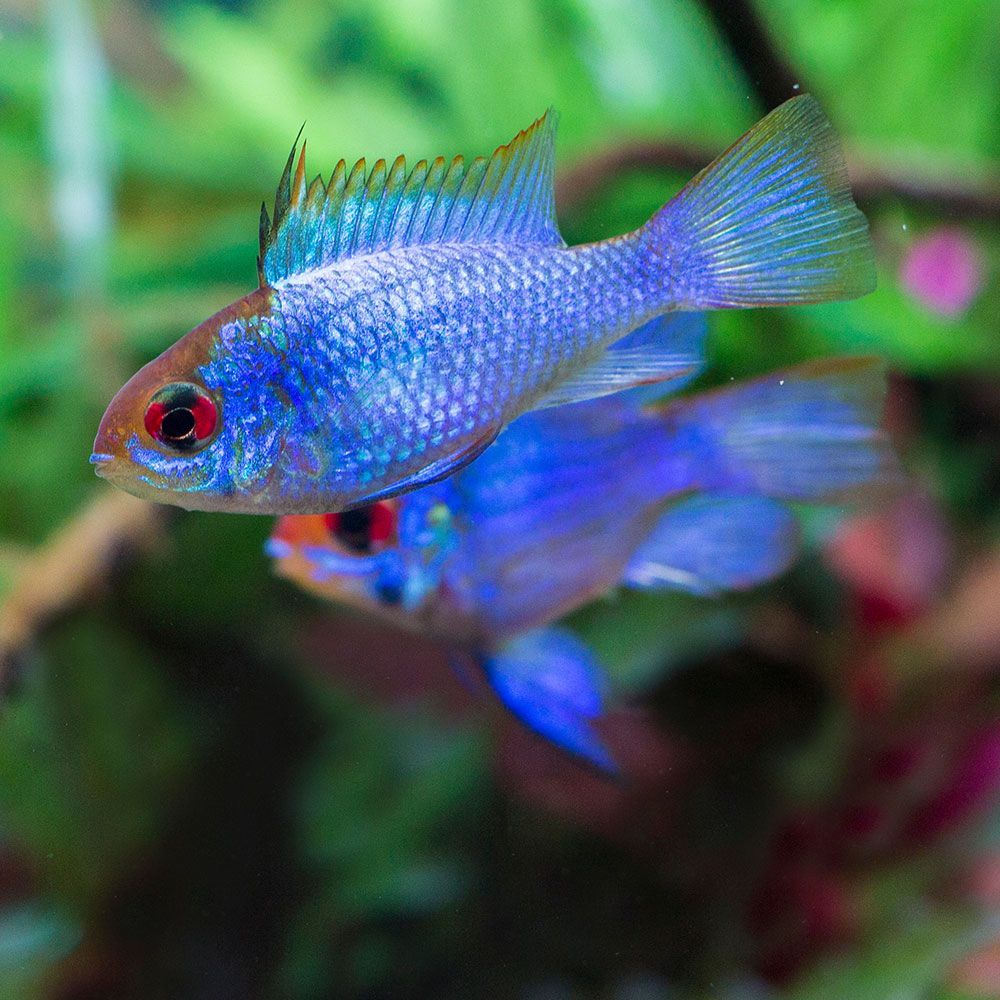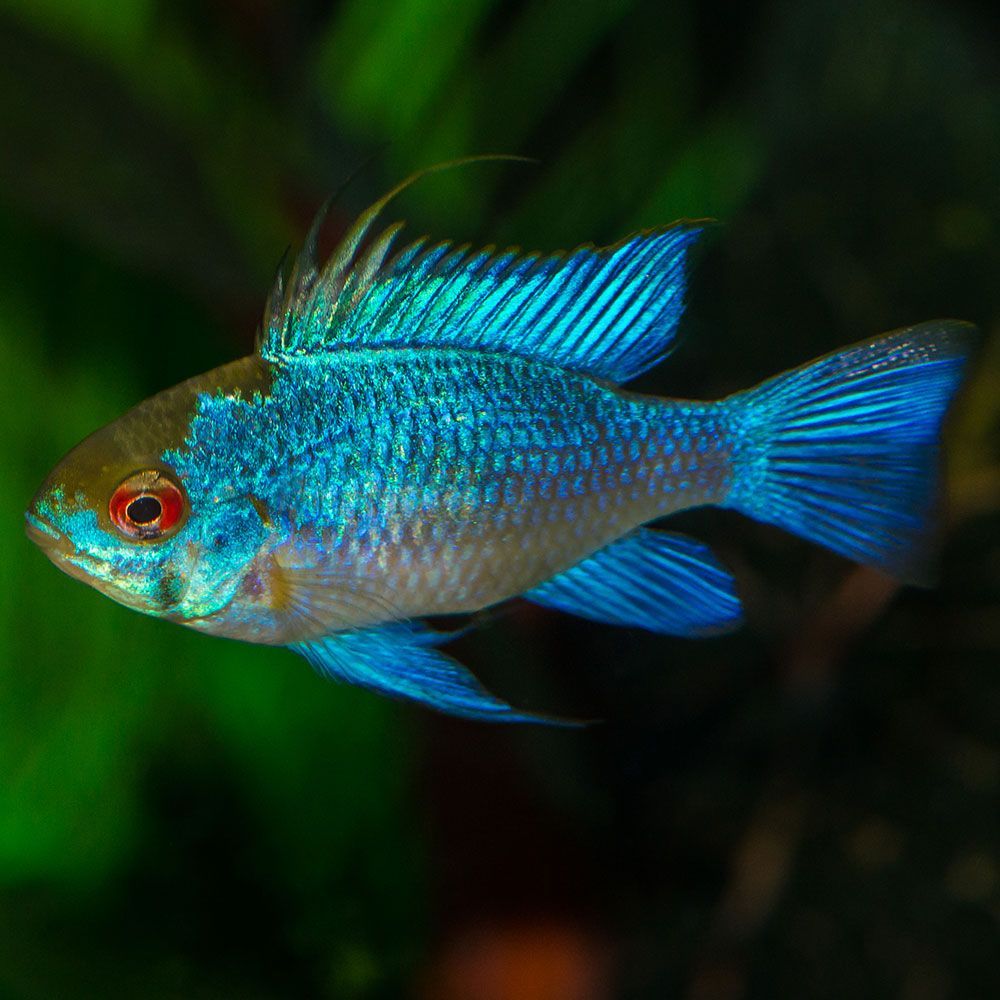This ram cichlid color morph has taken the aquarium trade by storm. And why not, its amusing antics and shiny body is all worth the hype.
So, if you can’t wait to embrace this majestic bright blue fish in your tank, let’s keep reading!
What is Electric Blue Ram Cichlid?
The electric blue ram is a gorgeous vibrant-colored freshwater fish. Whether you want a species-only tank or wish to build a community tank, it is a fantastic option due to its expressive yet gentle personality.
| Origin | Artificially bred |
| Order | Perciformes |
| Family | Cichlidae |
| Scientific Name | Mikrogeophagus ramirezi |
| Common Names | Electric blue ram |
| Appearance | Bright blue oval shaped with yellow marks on the forehead, pointy fins, and a greyish belly |
| Size | Up to 3-3.6 cm (1.2-1.4 in) |
| Lifespan | Usually up to 2-3 years, rarely 4 years |
| Temperament | Generally peaceful but aggressive and territorial during mating |
| Tank Level | Bottom to middle dwellers |
| Water Temperature | 78-86 °F (25-30 °C) |
| pH Level | 5.5-7.5 |
| Water Hardness | Up to 6 dGH |
| Care Level | Intermediate |
| Minimum Tank Size | 20 gallons for one, 30 gallons for a pair, 75 gallons for a small group or community tank |
| Tank Environment | Spacious, densely vegetated tank with low current and sandy bottoms |
| Diet | Omnivorous |
| Tank Mates | Own pair or school, other peaceful schooling similar-sized slow-moving species |
Which family does Electric Blue Ram Cichlid belong?
In 2009, an artificial strain of ram cichlid, popularly known German ram cichlid of South America, was created using selective or line breeding. This strain was named electric blue ram owing to its striking color.
Obviously, the strain doesn’t exist in the wild and hasn’t been introduced into the wild, either.
Being a color morph, the electric blue ram shares the same scientific classification as that of the ram cichlids.
It belongs to the order Perciformes and the family Cichlidae, and its binomial name is Mikrogeophagus ramirezi.
Fun Fact: Despite the sensitivity and low longevity of electric blue rams compared to German blue rams, they are more pricey and in demand.
How do Electric Blue Ram Cichlid look?

Now, if you’re curious about how an electric blue ram looks, let me break it down for you right here!
What is the size of Electric Blue Ram Cichlid?
This adult electric blue ram grows to a size of up to 3-3.6 cm (1.2-1.4 in). However, since it’s a result of artificial breeding, the size may vary a lot depending on the predecessor of the fish.
What is the color of Electric Blue Ram Cichlid?
The dwarf fish species has a striking bright blue body color. Its red eyes usually have a black dot or stripe. There’s also a brownish-yellow irregular patch on its forehead. Its belly and head have a more greyish tone to the blue.
In dim lights, the fish looks pearly white in color. In other lighting, it may also flaunt a subtle green, yellow, or deep purple shine.
What are the Features of Electric Blue Ram Cichlid?
Electric blue ram has an oval bilaterally symmetrical body with pointy, long, and rayed fins. Its dorsal fins are spiky, which begins from the gills and ends right before the tail fin.
You may find several variants of this species, like short-finned, long-finned, high-finned, lyre-tailed, veil-tailed, and so on. Like each of their names, each type has a distinct fin or tail type.
There’s another selective and inbred variant called the electric blue “balloon” ram, which has a shorter, stockier body than the actual one. This was a defective variant but is now bred intentionally due to its popularity.
The balloon variant has a much shorter lifespan than the regular electric blue ram. This is specifically because they are more susceptible to diseases.
How does a Male and Female Electric Blue Ram Cichlid differ?
It’s pretty hard to sexually differentiate electric blue rams. Both males and females are vibrantly colored.
Usually, the adult male has a longer body and longer dorsal and pelvic fins than the adult female. On the other hand, the mature female fish has a plump and round body.
How do Electric Blue Ram Cichlid Behave in the Tank?
Electric blue rams are usually peaceful and friendly towards other species. In fact, they are much more mellow-tempered compared to German blue rams.
Electric blues, however, can become aggressive and territorial during the mating season.
What is the Lifespan of Electric Blue Ram Cichlid?
Electric blue ram lasts only up to 2-3 years. However, my experience shows that generous care can help them live up to 4 years.
Author’s Note: The fish is extremely sensitive to stress which may drop its life expectancy much more. So, try your best to consistently maintain the right conditions and let it thrive for longer.
How to take care of Electric Blue Ram Cichlid?

Now, if you’re ready to commit to this fish, let’s prepare the perfect space for it with these guidelines!
What is the tank size for Electric Blue Ram Cichlid?
If you only plan to breed one electric blue ram, a 20-gallon tank will be enough. However, if you get a mated pair, at least 30 gallons is necessary.
However, if you want a small group of juvenile electric blue rams or build a community tank with it, invest in a 75-gallon tank.
What is the Water Chemistry for Electric Blue Ram Cichlid?
After undergoing several years of selective breeding, this variant is pretty touchy about water conditions. So, try to maintain the following levels at all times!
- pH Levels: 5.5-7.5
- Water Temperature: 78-86 °F (25-30 °C)
- Water Hardness: Up to 6 dGH
- Carbonate Hardness: Up to 5 dKH
- Ammonia: 0 ppm
- Nitrite: 0 ppm
- Nitrate: Below 20 ppm
What is the Tank Environment for Electric Blue Ram Cichlid?
Next, you must try to create an inviting ambiance for your fish to make it feel comfortable.
Is Substrate required in the Electric Blue Ram Cichlid Tank?
Use fine dark sand as a substrate for this aquarium. Since the fish spends long hours digging and scavenging for food on the tank bottom, this will protect the fish from getting hurt. And the dark substrate will also allow the fish to pop brightly.
But specifically, avoid aragonite sand or “cichlid sand” as these might release unwanted minerals in the tank and affect your pet fish’s health.
Are Plants needed in Electric Blue Ram Cichlid tank?
The electric blue ram is pretty timid, so add plenty of vegetation in the tank as hiding spots. It isn’t strong enough to destroy your plants but may dig the roots. So, invest in particularly strong rooted plants like hornwort, water wisteria, java fern, anubias, or Amazon swords.
What type of Lighting is required for Electric Blue Ram Cichlid?
To make your pet fish feel secure, use dim to moderate lighting in your aquarium that comes with a 12-hour timer.
What Décor is needed for Electric Blue Ram Cichlid aquarium?
To help the fish hide when it feels insecure, you can add lots of caves, toppled flower pots, and driftwood. A few waterworn rocks are a great addition as spontaneous spawning sites.
To maintain the pH of the water, add leaf litter or peat moss balls at the tank bottom. The released tannins will make the water acidic. However, you must regularly change the leaves.
Which Filter is needed for Electric Blue Ram Cichlid?
Invest in a strong and reliable oxygenating filter to maintain a healthy environment in the tank and protect them from getting sick.
What is the Water Flow Rate Required for Electric Blue Ram Cichlid?
Like the naturally found rams, the electric blues also enjoy minimal current in the water. So, maintain a low water flow at all times.
Fish Care Tip: Never add electric blue rams in a new aquarium, or it’ll be affected by “new tank syndrome”. Let the tank mature for 6-8 weeks and reach stable water parameters and only then bring the fish home.
What do Electric Blue Ram Cichlid Eat?
Electric blue ram is omnivorous, so feed it a high-quality, balanced diet of live, dried, or frozen variants of the following:
- Insects
- Small invertebrates
- Plant matter
- Fish flakes
- Fish pellets
- Bloodworms
- Shrimp
- Tubifex
- Leafy vegetables like cabbages and lettuce
Feed them twice a day for only 2 minutes at fixed times to maintain a healthy routine. If other fast-swimming species steal their food, make sure you put the food near the electric blue ram with a tong.
Lastly, eliminate any leftover food to avoid contaminating the water faster.
Feeding Tip : After being relocated to a new aquarium, the fish gets stressed and may even refuse to eat. So, help it build back its appetite by feeding it pellets, flakes, and mosquito larvae,
What are the Tank Mates for Electric Blue Ram Cichlid?
The presence of peaceful, docile, slow-moving schooling species acts like dither fish for the electric blue ram. Some great tank mates for it are:
- Kuhli loaches
- Dwarf gouramis
- Small tetras
- Cory catfish
- Bristlenose plecos
- Rasboras
- Dwarf crayfish
- Similar-sized shrimps
- Similar-sized snails (apple and nerite snails)
- Otocinclus
- Guppies
- Swordtails
- Platies
- Mollies
Which Tank Mates to Avoid Keeping with Electric Blue Ram Cichlid?
To keep your electric blue ram safe for long, avoid housing with the following types of species:
- Aggressive species: They will stress the ram and make them sick
- Quick swimming species: They may steal your ram’s food
- Smaller species that fit its mouth: They may get preyed on
- Similar colored species: Dominant electric blue ram males may show aggression towards them to be on top of the hierarchy
So, to name a few, some poor tank mates are the following:
- African cichlids
- Jack Dempsey cichlids
- Oscar fish
- Tiger barbs
- Red-tailed sharks
- Bichirs
- Small snails
- Small shrimps
- Large plecos
What are the Common Diseases Associated with Electric Blue Ram Cichlid?
Due to multiple inbreeding and selective breeding processes, the species is susceptible to the slightest changes in its environment. So, be prepared to deal with these:
| Disease Name | Causes | Symptoms | Treatment |
|---|---|---|---|
| Ich | Protozoan Parasitic Infection | Small white spots, flashing, inactivity, appetite loss | Add aquarium salts or ich medicines, raise the water temperature |
| Fin rot | Bacterial Infection | Fin fraying, fin disintegration, fin redness, fin discoloration, inactivity, appetite loss | Improve water conditions, remove harmful objects, add antibiotics |
| Hexamita | Protozoan Parasitic Infection | Hemorrhage on head, sores and holes on head, excess mucus secretion, red feces, appetite loss | Administer antifungal treatment right away |
| Columnaris | Bacterial Infection | Greyish-white patches, frayed fins, inactivity, appetite loss | Improve water conditions, add antibiotics, reduce stress |
Quick Tip: With a reliable testing kit, regularly check the water conditions once a week to maintain strict parameters. Perform 25% water changes weekly. Clean the filter media and wipe down both outer and inner tank glass surfaces monthly.
How to Breed Electric Blue Ram Cichlid in an Aquarium?
Before you try to breed electric blue rams, know that this fish is hard to differentiate sexually. The fish also forms monogamous pairs and won’t randomly bond with any specimen of the opposite gender.
Though some shops might sell bonded pairs, beware that you’d have to shell out a hefty price.
So, always buy a group of juvenile fish and then get naturally bonded pairs from them. Once you get the pair, condition them with high-protein food like brine shrimp, daphnia, and bloodworms.
Once that’s done, follow these steps:
What is the Tank Preparation Required for Breeding Electric Blue Ram Cichlid?
In a 30-gallon tank, add soft sandy substrate, lots of flat waterworn stones, and a timer-set lighting with the following water parameters:
- pH Levels: 5.5-6.5
- Water Temperature: 82 °F (28 °C)
Mature the tank for 8 weeks to stabilize the conditions.
What is the Mating Procedure for Electric Blue Ram Cichlid?
Introduce the conditioned pair to a matured breeding tank. They nudge and twirl around each other. The male fish might even brush and slide against the female fish to persuade her into mating.
When the pair feels ready to mate, they choose and clean a stone or dig holes as spawning sites. The female then lays from 20 to more than 500 sticky eggs of up to 1.5 mm. The male fish then spreads its milt over the eggs.
What is the Incubation Period for Electric Blue Ram Cichlid Eggs?
The female fish tends to the eggs throughout the incubation phase so they don’t catch fungus or bacteria, while the male fish defends the entire territory. The parent fish consumes the infected or non-viable eggs to protect the other eggs.
With a steady temperature, the eggs hatch after 40 hours, and the fry consumes its egg yolk. Otherwise, it takes up to 4 days. Biparental care and protection continue even after the hatching.
After about 5 more days, the fry swims freely alongside their parents. Feed the young fry baby brine shrimp, infusoria, and commercial fry food.
When to Separate Male & Female Electric Blue Ram Cichlid?
An established pair breeds once a month, so relocate the fry to another tank by the time they are a month old. Continue their original diet and increase the amount gradually. You must also slowly feed them adult fish food.
What are the problems in breeding Electric Blue Ram Cichlid?
Inexperienced pairs may often eat their own brood, but no need to get agitated about that. Let the pair spawn a few more times, and they’ll learn to care for their little ones.
But if this continues for too long or an experienced pair (pair that have raised fry before) does this, there might be some issue.
If you bred them in a community tank, remove any other fish from the tank. Maintain the water parameters properly and try to add more hiding spots.
Breeding Tip: Due to endless selective and inbreeding, electric blue rams are often found to be infertile or produce a non-viable brood. So, be prepared to get disappointed.
How to Buy Electric Blue Ram Cichlid?
Electric blue rams are pretty rare and more expensive than other rams. So, don’t buy it, if you get it for cheap. Those specimens might have been hormone induced and won’t last for long.
A word from FishInAquarium
Electric blue rams are no less than a feast to the eyes. They may be a bit more needy and require more experience in fishkeeping. But all that hard work is worth it with that unique splash of blue in your aquarium.
With that said, if you’re ready to get these lovable fin buddies home, share it with other hobbyists and have your own electric blue gang. And if you guys face any setbacks in your journey, let us know via mail, and we’ll help you get back at it!


